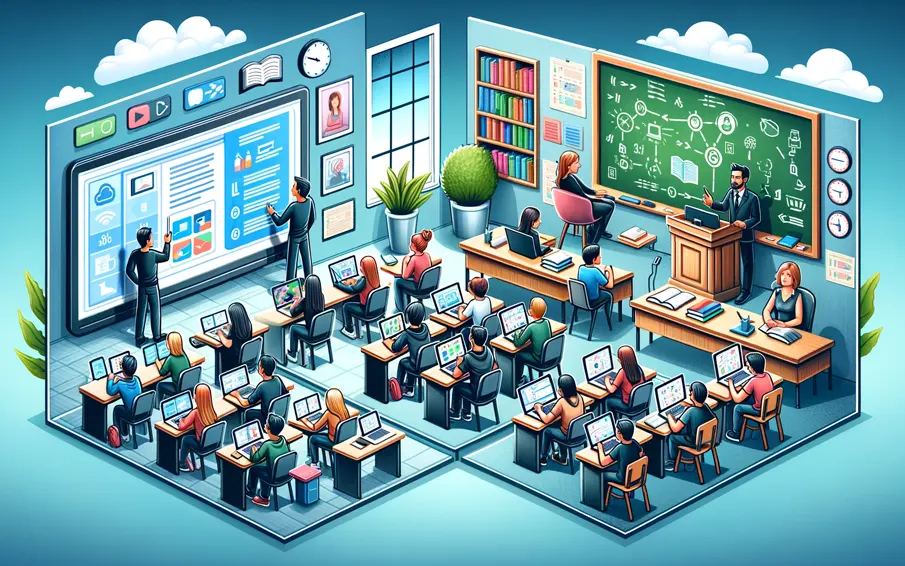Are you thinking about taking a course but traditional classroom learning seems overwhelming? Maybe you’re a busy professional or a parent with limited time. The good news is, online education has become a powerful alternative.

Both online learning and traditional classroom learning have their own advantages and disadvantages. This blog aims to break down the key differences between the two in 2024. By understanding these differences, you’ll be better equipped to choose the learning method that best suits your needs and learning style.
Learning Environment
The learning environment is a critical factor to consider when choosing between online and traditional learning. It can significantly impact your learning experience and overall success. Here’s a breakdown of the key differences:
- Traditional Learning: Imagine a familiar brick-and-mortar classroom setting. You’ll have a teacher at the front leading instruction, delivering lectures, and guiding discussions. This fosters a strong sense of community as you interact face-to-face with your classmates and instructor. However, traditional learning can be inflexible. Classes have fixed schedules and locations, which might not be ideal for busy professionals or learners with geographically limited options.
- Online Learning: On the other hand, online learning offers a completely different landscape. It embraces both asynchronous and synchronous learning options. Asynchronous learning allows you to learn at your own pace, reviewing course materials like video lectures, readings, and assignments whenever it fits your schedule. Synchronous learning provides real-time interaction through video conferencing, online discussions, and chat rooms. This flexibility is the hallmark of online education. You can learn from anywhere, anytime, as long as you have a reliable internet connection. So, whether you’re juggling a demanding job or managing family commitments, online learning can accommodate your unique needs.
Interaction and Engagement
The opportunity to connect and engage with others is a cornerstone of a fulfilling learning experience. However, the way this interaction unfolds differs significantly between online and traditional learning methods. Traditional classrooms provide a natural environment for building connections. Face-to-face interactions with classmates and instructors allow for real-time discussions, group work, and immediate feedback. This can be ideal for learners who thrive on social interaction and collaborative learning. However, participation opportunities can be limited in large classes, and some students might feel hesitant to speak up in person.
Online learning, on the other hand, fosters engagement through a different set of tools. While the lack of physical presence might seem like a drawback, online courses leverage discussion forums, chatrooms, and video conferencing to create a sense of community. Learners can participate in discussions at their convenience, contribute written thoughts, or engage in real-time conversations. However, online engagement requires a high degree of self-discipline and time management to actively participate in discussions and stay connected with the course community.
Cost and Resources
The financial aspect and access to resources are crucial considerations when choosing between online and traditional learning methods. Here’s a breakdown of the key differences:
Traditional Learning:
- Higher upfront costs: Tuition fees, textbooks, course materials, and potentially transportation and accommodation costs can add up significantly.
- Limited resource access: Library resources might have limited hours or availability, and access to specific materials or equipment could be restricted.
Online Learning:
- Generally lower overall cost: Online programs often have lower tuition fees compared to traditional programs, and there are typically fewer associated costs like textbooks or transportation.
- Vast and readily available resources: Online courses often provide all necessary materials within the learning platform, and learners have 24/7 access to a wealth of online resources for further exploration.
Conclusion
The landscape of education has evolved significantly, offering both online and traditional learning as viable options. We’ve explored the key differences between these methods, from the learning environment and pace to interaction and cost. Ultimately, the best choice depends on your individual needs and learning style.
Consider these factors:
- Flexibility: Do you need the flexibility of online learning or prefer the structure of a traditional classroom?
- Learning Style: Do you thrive on interaction or prefer self-paced learning with a variety of resources?
- Budget: Are you working with a tight budget or willing to invest in a traditional program?
By carefully considering these factors and the strengths and weaknesses of each method outlined in this blog, you can make an informed decision that best positions you for success in your learning journey. Remember, there’s no single “right” answer. The ideal learning environment is the one that allows you to effectively engage with the material and achieve your educational goals.


